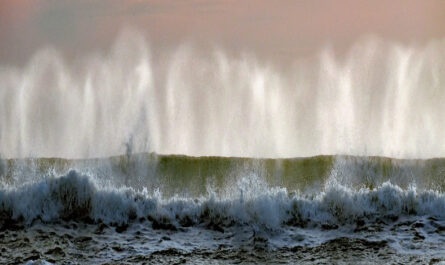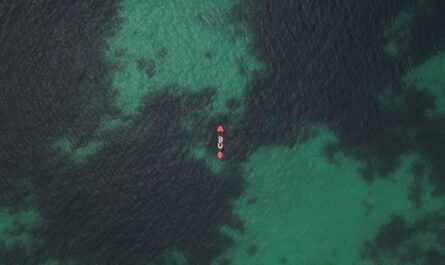Climate change is no longer a distant threat; it is an ever-present reality, especially for coastal cities and island nations across the Atlantic. Sea level rise is one of the most direct and destructive consequences of global warming, as melting ice caps and glaciers, combined with the thermal expansion of seawater, contribute to gradually rising ocean levels. The Atlantic Ocean, bordered by numerous densely populated cities and vulnerable island nations, is at the forefront of this battle.
From Miami and New York City in the United States to island nations like the Bahamas and the Maldives, rising seas are forcing governments, scientists, and communities to rethink urban planning, infrastructure, and resilience strategies. While the effects of sea level rise vary depending on geography, the challenges posed by climate change demand global cooperation and immediate action. This article explores the causes and impacts of rising seas in the Atlantic, examines how coastal cities and island nations are coping, and looks at the future solutions that could help mitigate the worst outcomes of climate change.
Understanding Sea Level Rise: The Science Behind the Crisis
Sea level rise is driven by two primary factors linked to climate change: the melting of land-based ice (such as glaciers and ice sheets) and the thermal expansion of seawater as it warms. Both phenomena are directly related to the increase in atmospheric temperatures caused by human activity, primarily the burning of fossil fuels, deforestation, and industrial emissions that release large amounts of greenhouse gases, particularly carbon dioxide (CO₂).
- Melting Ice Caps and Glaciers: As global temperatures rise, glaciers and ice caps, especially in Greenland and Antarctica, are melting at an accelerated rate. These large bodies of ice are vital components of Earth’s climate system, and their rapid melting is adding vast amounts of freshwater to the oceans. According to recent estimates, Greenland alone is losing about 280 gigatons of ice per year, significantly contributing to global sea level rise.
- Thermal Expansion: When water heats up, it expands. This seemingly small change in water volume has a significant impact on sea levels. The Atlantic Ocean, like other oceans, is absorbing much of the excess heat trapped by greenhouse gases in the atmosphere, leading to thermal expansion and a gradual increase in sea levels. This effect is compounded by regional factors, such as ocean currents and wind patterns, which can cause sea levels to rise unevenly across different parts of the world.
The Impact of Rising Seas in the Atlantic
Sea level rise is a gradual process, but its impacts are already being felt by coastal communities and island nations in the Atlantic. These impacts include more frequent flooding, coastal erosion, saltwater intrusion, and the loss of natural barriers like wetlands and coral reefs, which traditionally protect coastlines from storms and surges.
1. Coastal Cities: Rising Waters and Urban Resilience
Coastal cities, home to millions of people, are particularly vulnerable to rising sea levels. From Miami to New York City, Atlantic coastal cities face significant challenges as they deal with increased flooding, damage to infrastructure, and threats to real estate and local economies.
Miami: Battling Tidal Flooding
Miami is one of the most at-risk cities in the world when it comes to sea level rise. Built on porous limestone, the city is particularly vulnerable to “sunny day” or “nuisance” flooding—when high tides and rising sea levels combine to flood streets without any storm activity. This phenomenon is occurring more frequently, with some areas of Miami Beach now experiencing several flooding events a year.
In response, Miami is investing heavily in resilience strategies. The city has begun elevating streets, installing pumps, and creating stormwater drainage systems to manage the increased water levels. Miami is also revisiting its building codes to require new constructions to be built at higher elevations. However, these measures come with enormous costs, and there are concerns about how long they will remain effective as sea levels continue to rise.
New York City: Protecting a Global Hub
New York City, one of the world’s most populous and economically significant cities, is also grappling with the threat of rising seas. Superstorm Sandy in 2012 highlighted the city’s vulnerability, as floodwaters inundated lower Manhattan, submerging subway systems, causing power outages, and resulting in billions of dollars in damages.
In the aftermath of Sandy, New York City launched a series of ambitious projects aimed at increasing resilience. The Big U project, for example, is a proposal to build a series of levees, parks, and seawalls around lower Manhattan to protect the city from storm surges and rising seas. Other initiatives include upgrading infrastructure to withstand flooding, elevating electrical systems, and creating natural buffers, such as wetland restoration projects, to absorb floodwaters.
Despite these efforts, New York City faces significant challenges due to its aging infrastructure and the sheer scale of the work required to protect its millions of residents. Long-term planning and ongoing investment are crucial if the city is to mitigate the impacts of sea level rise in the coming decades.
2. Island Nations: On the Frontlines of Climate Change
For island nations scattered throughout the Atlantic, the threat of rising sea levels is even more existential. These small island developing states (SIDS) are some of the most vulnerable places on the planet, with limited resources to adapt to climate change and little room to relocate their populations. Many of these islands are facing not just a loss of land but also threats to their economies, which often rely heavily on tourism and fisheries—both industries deeply connected to healthy coastlines and marine ecosystems.
The Bahamas: Facing a Dual Threat
The Bahamas is one of the most iconic island nations in the Atlantic, known for its stunning beaches, clear waters, and vibrant coral reefs. However, the country is also one of the most vulnerable to rising seas and extreme weather events. In 2019, Hurricane Dorian, a Category 5 storm, devastated parts of the Bahamas, flooding entire islands, destroying homes, and displacing thousands of people.
Sea level rise is exacerbating the risks posed by hurricanes, as higher water levels mean that storm surges are more destructive. Additionally, the Bahamas’ low-lying geography—most of the islands are less than 16 feet above sea level—puts much of the population at risk of displacement in the future.
To cope with these challenges, the Bahamian government has been working to strengthen its disaster preparedness and build resilience. Efforts include better early warning systems, stricter building codes, and a focus on restoring and protecting natural barriers like mangroves and coral reefs. These ecosystems help protect the islands from storm surges by absorbing the energy of incoming waves.
The Maldives: A Nation in Crisis
Though located in the Indian Ocean, the Maldives shares many of the same vulnerabilities as Atlantic island nations. With an average elevation of just 3 feet above sea level, the Maldives faces an existential threat from rising seas. Projections suggest that much of the Maldives could be underwater by the end of the century if global sea levels continue to rise at the current rate.
In response, the Maldives has embarked on an ambitious project to create artificial islands that are elevated above sea level. These islands, like Hulhumalé, are being built with the intention of relocating parts of the population and ensuring that critical infrastructure, such as airports and hospitals, remains above water.
While the Maldives’ approach is innovative, it highlights the limitations that many island nations face in adapting to climate change. For countries with fewer resources, such solutions may not be feasible, underscoring the need for global cooperation in addressing climate change’s impact on vulnerable communities.
Global and Local Solutions to Rising Seas
As sea levels continue to rise, coastal cities and island nations are increasingly looking to innovative solutions to protect their populations, economies, and ecosystems. While no single solution can fully mitigate the effects of sea level rise, a combination of strategies—ranging from engineering feats to nature-based solutions—offers hope.
1. Engineering Solutions: Levees, Seawalls, and Floating Cities
One of the most direct responses to rising seas is the construction of physical barriers, such as levees, seawalls, and floodgates. These structures are designed to hold back the ocean and protect coastal infrastructure from storm surges and high tides. Cities like Venice, New Orleans, and Rotterdam have implemented such systems, with varying degrees of success.
Looking to the future, some architects and urban planners are exploring more radical concepts, such as floating cities. These futuristic urban environments would be built on platforms that rise and fall with the tides, allowing populations to live on the water without being affected by sea level rise. While still in the early stages of development, floating city concepts are gaining attention as a potential solution for particularly vulnerable regions.
2. Nature-Based Solutions: Restoring Natural Barriers
In addition to engineering solutions, many coastal cities and island nations are turning to nature-based solutions to combat rising seas. These approaches focus on restoring and preserving natural ecosystems that act as buffers against flooding and erosion.
Mangroves, wetlands, and coral reefs are some of the most effective natural defenses against sea level rise. These ecosystems absorb the energy of waves, reduce coastal erosion, and provide critical habitat for marine species. In the Caribbean, for example, efforts to restore mangrove forests are helping to protect coastlines from storm surges while also providing environmental benefits like carbon sequestration and biodiversity support.
Similarly, coral reef restoration projects are underway in places like the Bahamas, where healthy reefs act as natural barriers against rising seas and powerful waves. By investing in the restoration of these ecosystems, communities are not only protecting their coastlines but also bolstering local economies that rely on tourism and fisheries.
3. Policy and Global Cooperation: The Need for Collective Action
Addressing sea level rise requires a global response, as the root causes of climate change are not confined to any single nation. International agreements, such as the Paris Agreement, aim to limit global warming to below 2°C, a threshold that scientists believe is necessary to avoid the worst impacts of climate change, including catastrophic sea level rise.
However, meeting these goals requires a concerted effort from all nations, especially major emitters of greenhouse gases. Reducing emissions, transitioning to renewable energy sources, and implementing sustainable development practices are critical steps in mitigating sea level rise.
At the same time, wealthier nations have a responsibility to support vulnerable coastal cities and island nations, many of which contribute little to global emissions but are disproportionately affected by climate change. This support can come in the form of financial aid, technological assistance, and capacity-building programs that help these nations build resilience and adapt to the changing climate.
Conclusion: Adapting to a Changing Future
The rising seas of the Atlantic present an urgent challenge for coastal cities and island nations. As climate change continues to accelerate, these communities must find ways to adapt and protect themselves from the encroaching ocean. From Miami’s flood pumps to the Bahamas’ mangrove restoration efforts, there is a growing recognition that innovative solutions, both engineered and natural, are needed to combat rising sea levels.
However, adaptation alone will not be enough. To truly address the problem, the world must take decisive action to reduce greenhouse gas emissions, slow the pace of global warming, and prevent the worst outcomes of climate change. Only through a combination of local resilience efforts and global cooperation can we hope to safeguard the future of coastal cities and island nations against the rising tides of the Atlantic.



